#except that cinematography here is by
Explore tagged Tumblr posts
Text








Gael García Bernal in El crimen del padre Amaro (2002, dir. Carlos Carrera)
Gifs are all 540px wide so you can click to see larger.
[other gael filmography gifsets]
#gael garcía bernal#el crimen del padre amaro#ggb filmography gifs#gael garcia bernal#the crime of father amaro#we're back into 'surely most people have seen this one' territory so i don't have much to say#except that cinematography here is by#guillermo granillo#< that is a tag no one has used on tumblr before which feels like a travesty
47 notes
·
View notes
Note
top 5 movies of all time?
all time films ? sorry this may take some time because i'm not gonna just put my letterboxd top 4 + 1 more
reservoir dogs
mamma mia!
can i just put the entire lord of the rings trilogy as one answer. if not fellowship of the ring
the godfather
the silence of the lambs
#films#except for res dogs i've basically ignored my current favs#because i'm letting some film i would put down as all time best beat out current favs. like no one does cinematography#anywhere near like tlotr trilogy. the performances in tsotl puts it a head above 90% of films from that century imo#also i love them still ofc but their greatness is rlly what puts them here over the bad films i love
4 notes
·
View notes
Text
You know, the thing is that Agents of Shield always did really feel like a spin off tv show where interesting as it could be sometimes (it's definitely a... deeply flawed, show, I still haven't managed to finish it), where as Clone Wars really does feel like expanded lore despite the fact neither of them ever would or could have any impact on any of the movies
I'm kinda sat here wondering why that is, cause in my rewatch I'm hitting the part that's happening at the same time as episode 3 and it's like... Asoka is in essence a fan fic character compared to the movie canon, you know that none of the stuff involving her was ever thought of when that movie was made (I assume anyway) and yet the show does a good enough job that it does feel like she actually has an impact, that clone wars helps contextualize a lot of episode 3 (for the better, on it's own it's... ok)
Is it just better writing? Is it that it came along long after the movies while Shield was running along at the same time as the MCU? Definitely the first season of that show is the strongest when all the Hydra stuff with Winter Soldier is happening, but later on it often does feel like "oh boy, glad we managed to build this helicopter in time, glad it could help deal with that Age of Ultron(tm)"
So I don't know... I just think it's probably worth figuring it out what the difference between two shows that both would never ever be able to impact the movies they're associated is, that makes one really feel like a tv spin off and one feel like actual strong world building that did have an impact even if it literally can't because it came out after literally every movie (that matters) was already made
What did they do right, you know?
#also boo all these stupid shitty disney star wars shows coming out... I kinda don't even care if they're good or bad; I'm sick#mando sounded like it was good at first then went wildly off the rails#I've heard alderan is good but also I just... can't care and also really don't like something about live action disney star wars tv...#...well... can't put my finger on it... costuming? lighting? cinematography? make up? I don't know; but something feels off#but also they just make so many stinkers like... acolyte sounds awful#nah; no thanks; I'll stick to Rebels and Clone Wars; two shows that start off... kids show-y (hahaha da big alien fart!)#but both develop into really really solid stories in their own right with really cool characters who flesh out the universe#...which is kinda the exact reason I've got no interest in Asoka as a show... nah; she's great in Clone Wars#and it's a 'oh damn; look who it is!' moment when she shows up in Rebels#and uh... I'd rather leave things up in the air than trust disney to do anything else with her story#disney just doesn't make good things anymore... I don't know what the last quality thing they even made#and I bet whatever it was I mostly liked but had problems with#anyway... real point of the post is just I wonder what we can learn about writing here#but the secondary part of the post is I love star wars except for hating it
0 notes
Text
and worse
started good omens book!! how does it manage to be quirkier than the show
#one thing about me is that the book is always better#except for in this case#it was just so unfunny after a few pages and then i was in the trenches for the rest#type of story that REALLY needs the good acting and cinematography to be enjoyable#also i guess it speaks to the fact that i like season 2 better#i'm here for the ineffable idiots not some random biker gang???#that part was whack#also the authors really liked being mildly racist every few chapters like can you come up with anything else 🧍#good omens#book omens#june reads
3 notes
·
View notes
Text
helloooooo welcome to my account :)
here are my most popular stranger things posts, most of which are byler related, including theories and analyses. some of these were also covered on my tiktok back in the day. i've colored my favorites/the ones i think are the most important:
season 4
Mike's self-pity parallel
Airport shenanigans
Rink o mania lighting
El does not trust mike
Mike dropping everything to fight with will
When blue meets yellow in the west is NOT reach
It's been a year, Mike. (byler s4 analysis/theory)
Harry Potter parallel
Byler being paralleled to canon couples
the whole point of Dear Billy...
Mike is a guilty liar
Mike wont stop whining about it. (byler phone theory)
Bedroom scene script analysis
Byler Romione parallel
Breaking down Mike's apology
You ruined my day!/You basically sabotaged the whole day!
Rink-o-mania detail
Mike/hopper parallel
Season 4 themes analysis
byler/rovickie parallel
Ell/Will parallel
Mike lying vs Mike telling the truth (mileven/byler parallel)
Discogate
max & lucas vs mike & el
mike was lying in the monologue
season 3
lucas the wingman
mike/hopper 'corruption' parallel
s3 finale scenes analysis
byler blocking
mlvn vs jancy cinematography
the concept of liking girls...
love triangle imagery
season 2
What was the point of it was the best thing I've ever done?
El/Will upside down parallel
why the emphasis on mike?
how to make an intimate scene
jancy/byler scenes
mike being weird at the snowball
season 1
mike lashing out at el
mike treats all his best friends the same...except will
stancy +mileven music coding
byler being built up from s1
general analyses
Stancy/joyce & bob/mileven parallel
HEARTGATE
The biggest byler proof
el does not trust mike
Mike's weird language when he talks about el
Stranger Things Music Coding
every time we've heard 'I love you' in stranger things (ongoing)
El's makeovers/Elmax analysis
why i stopped shipping mileven
how mlvn could've been likable
"Will is mad at me I hope I die"
Byler if there was no heteronormativity
Use of flashbacks in stranger things (not my post but it is inspired by a discovery i made and it's incredible so give it all the love)
more will be added as i post more!
#byler#will byers#mike wheeler#stranger things#byler endgame#byler analysis#stranger things analysis#stranger things theory#byler thoery#el hopper#max mayfield#jonathan byers#nancy wheeler#joyce byers#jim hopper#steve harrington#robin buckley#lucas sinclair#dustin henderson#lumax#elmax#jopper#anti mileven#mileven is bones
166 notes
·
View notes
Text
SOTUS Review: Engineering the Bridge To BL
I'm not exactly a sucker for teen dramas. Miss me with Gossip Girl and Pretty Little Liars. Even less soapy shows like The OC or Dawson's Creek that I checked out because of their critical status in the genre were not shows that I felt compelled to finish after watching a few episodes. However, teen dramas were a rare space in media where queer characters were allowed to exist as secondary or tertiary characters, so in my young gayhood I searched amongst less popular shows for gay storylines like in Canada's Degrassi. I binge-watched Australia's Dance Acadamy until they killed off the gay character and sought out lists about groundbreaking shows from before my time like My So-Called Life.
The latter is not simply exceptional for its gay representation but for aiming higher than its teen soap peers for realist complexity in its characters. Later, shows like Freaks and Geeks and the UK's Skins would take up that torch, then Friday Night Lights, which had the genius to bring in the institution of American football culture in the South of the the US to ground its commentary on American racial and economic politics. Norway's Skam arrived in 2015 using the "Russ Bus" tradition for similar purposes--and used the strength of its writing to depict a globally celebrated queer story the same year as SOTUS. These elevated coming-of-age teen dramas I count among my favorite series ever in any genre.
I bring up all this TV history because I found no review yet that adequately conveys SOTUS's equivalent storytelling goals and prowess, nor do they fully indicate that SOTUS is one of the most compelling BLs to this day. Historically important, they read, but mediocre production values, primarily for straight women and homophobic, with a hazing setting that might be triggering for viewers, all implying its a relic of a less enlightened time in BL history that later shows will improve upon. While I'd recommend reading them to learn more about the history of the series that I'm less interested in covering here, these are not exactly rave reviews. What a surprise to begin the series and witness right out of the gate precision, complexity, and depth to its queer depictions that's equal to any Thai BL that followed in its groundbreaking wake.
The series manages to engineer (wah wah) bridges to blend the naturalistic elements of those other elevated teen drama precedents with the tropes and styles that populated Thai BL novels (like the pink milk from 2Moons2) and will define Thai BL series in the years to come. In Thailand, the series Love Sick came first in its BL focus, but, as lovely as Love Sick is, it sprawls across flatter characters in its focus and fails to celebrate the breadth of queerness in some harmful ways. On the other hand, SOTUS, in pacing, casting, characterization, and theme development, links BL to a plot-driven Western style and decidedly queer perspective. There's a reason it was the show to begin the more intense global interest in BL series.
Below the cut, you'll find my review about the qualities that made SOTUS so outstanding to me.

SOTUS initially struck me with the tightness of its dialogues and cuts, especially compared to many other Thai BLs that I've seen, which have a bawdy theatrical spaciousness in their tempo, more in line with broad comedy or soap opera, telenovela, and Thai lakorn. Not so in SOTUS. It gives time enough for its actors to emote but orients toward storytelling precision. Plot-forward Thai BL comparables I've seen so far might be Not Me or Moonlight Chicken. Unlike those series, SOTUS won't be any cinematography nerd's dream, clearly limited by its budget in this matter, but it works hard to keep the limits of a small budget from distracting. The cheaply licensed scoring music, for example, is surprisingly effective, its repeated pulsing dread adding to the momentum ignited by the SOTUS initiation of the freshman at Thai universities.
Senior year of high school, I selected universities for application based on my fear of hazing. No fraternities near campus for me. The gendered organization and reputation for homophobic cruelty were existential threats to me as a closeted teenager. For many gay men, including myself, frat houses and initiation ceremonies were also sites of homoerotic fantasy. Thus is the duality of gay experience.
The Thai hazing context differs from the US (no gender segregation, for example), but the series mines the same psychological tension between danger and eroticism with its controversial use of the real-life SOTUS hazing induction system--the abbreviation stands for Seniority, Order, Tradition, Unity, and Spirit--to ground its queer romance. The actual implementation of it at Thai universities has more issues than the show depicts and, while the series' hazing is a form of bullying that can trigger some, the mildness of the abuse depicted ought to be stated, especially when compared to American ideas about hazing abuse and queer media's depictions of homophobic violence. SOTUS portrays shouted verbal instructions and physical endurance trials as the means of degradation, with no physical violence and reprimands with consequences when its believed seniors have disrespected their charges or put them at risk.
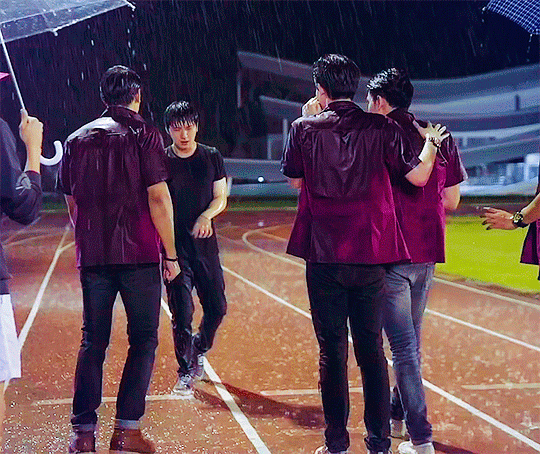
Rather than a critique of the SOTUS system itself, the system provides the organizational hub for the series' broader societal commentary, and itts treatment elevates the show to the likes of Friday Night Lights or Skam. Jane Austen's Pride & Prejudice title was taken from a line in Fanny Bruney's Cecilia about the two faults being both the cause of miseries and the reason for their termination. The series treats the SOTUS system and everything else within in the same manner: with complexity rather than binary keep-it-or-leave-it moralism. The S.O.T.U.S. values parallel the confines of a deeply imperfect society that when seen as strictly authoritarian pass down rules and pain from the elder generation to the the next. However, when viewed and practiced as the series encourages by the end of its story through a more nuanced understanding of the Asian filial philosophies at play, the values of seniority, order, tradition, unity, and spirit also invite compassion and affinity flowing in both directions across the generations.
The slowly emerging slight but significant age-gap romance between righteous freshman Kongpob and head 'hazer' Arthit is the central device for this exploration, but every element and scene, from the side couples to the food orders, develop our sense as viewers of the social order that the show wants to address. And the scenes move like well-lubricated assembly-line machinery toward their final purpose. It's obsession-inducing.
Despite the machinery of SOTUS's pacing, it delicately fashions its character and an environment gently permeated by homophobia and misogyny. Celebratory moments occurred to highlight themes without drawing attention to themselves, heterosexual coupling and marriages, for example, or a classmate coming out. Slurs surfaced casually, too, and old-fashioned masculinities were performed not as major plot points, spectacles of violence, or lessons for characters to immediately learn from, but to illustrate how inherited ignorance and constraints bear down almost invisibly on the characters. No one was demonized or ostracized for their ignorance, not because the writers view their actions positively but because they view their ignorance as a product of systematic failings, failings each generation can and will attempt to improve upon as they inherit the reigns. No one generation will make it all perfectly right. They are only human.

You can feel that humanity in the way the characters are written. All of the characters are distinguishable and interesting. They're written well and performed with heart. We have actual girls just chilling and being friends in a BL series, which was historically novel. Ingenues and horny girls and shy lesbians. The guys are recognizable guys, which is another feature Thai BL does exceptionally well. There are some dorks, some bros. The best friend in the freshman group is shy with strangers but open with his friends and fierce on the basketball court. I've known people like these. They are characters that are broad enough to recognize from a distance (or less screen time) but not simple stereotypes.
Then, on top of this you have the casual trans, gay, and nonbinary inclusion of bit parts and side characters that, to this day, only Thailand is doing in its shows to this extent. Its just impressive to see that their BL industry started off from the get-go at this level. But in SOTUS its not simply casual inclusion, either. These characters, unlike comparable characters in Love Sick, delineate moments of queer kindness that blur the understood hierarchical order of the initiation system and the heteronormative order holding our romantic leads back. In subtle ways they offer queer guidance and a model to Kong on his journey.

Then there's Kongpob and Arthit at the queer center of it all. Ugh! These two characters! These two performances! In Singto's watery sphynx-like eyes, in Krist's clinched jaw, in the electrified space between their bodies that the characters must restrain themselves against crossing, these are the heights of longing the romance genre can reach at its peak. There's an inner pain in these characters. That pain is old-school romance and its old-school queer pain.
I've read complaints about the physical intimacy in this show that I realize after watching the series are ignoring the characterizations of repression and inexperience that impact every interaction between Art and Kong, even their kisses. They aren't on the het timeline, instead having their first kiss and relationship in college, which is why SOTUS aligns with the teen drama genre so well despite its university setting. The greenness of their physical affection (we see it grow more competent and comfortable as the show progresses), however, belies an emotional chemistry that's intense, erotic, and intimate. Many more explicit BL scenes feel tame compared to Arthit grabbing Kong's shirt in rage or whispering in his ear in front of a waiting taxi.
I'm looking forward to SOTUS S and its Our Skyy episode to see more about KongArt's partnership, because their characters resist the seme/uke categorization of the BL genre they emerge from (which are also basically the stereotypes of top and bottom that gay men placed on themselves lol). Their ages and behaviors are reversed from the expected, first off. Kong, the younger, pursues, making him technically the seme and Arthit the uke, character definitions that also indicate sexual preferences of top and bottom. This wasn't unheard of in BL texts from what I've read, but less typical. Then there's the matter of Arthit being the one who initiates physical affection, partly due to Kong's regard for his challenges with internalized homophobia. Apparently, even the pronouns used between the pair are an intimate negotiation rather than an accepted order, returning us to the more complex ways the S.O.T.U.S. acronym can be enacted.
Plus, Kong's played by Singto with impressive power and confidence that's still soft-spoken, slippery, sibilant. To my trained eyes, its a character with mannerism and speech that are legibly gay. Not so legible that all his peers will notice, but he's clockable for queer eyes and worrisome for those afraid of deviation from the norm. For me, this is Thailand's biggest BL breakthrough (and its persisted down this path*) because, for many in the LGBT+ community, challenges begin well before anything to do with sexual attraction.

Gender deviance is the key issue. I was teased by a classmate at 8, well before I had a sexuality, that when I walk I move my hips like a f*gg*t. Don't worry. He wasn't totally wrong. I have a killer strut and I own it now. His antagonism wasn't about who I liked; it was my swish, my non-masculine behaviors. The hatred of gender deviance (and its misogynistic reasoning) is the underlying bogeyman for much of homophobia. Even plenty of men who are perfectly happy to have sex with men, at least where I live in the US, take issue with effeminacy. (Try finding the most overt lesbians on tv outside of OITNB, too!) That applies to audiovisual media, too. Unless comedic, consumers have tended to be more excited about queerness when the bodies and expressions appear in-line with gender expectations. The power of Thai BL and Singto's performance of Kong is how it opened space in the market and audience's minds to take queer affects seriously in young adult romance.
It's no surprise, then, that Kong forges friendships with the characters who are overtly LGBT during the series. The associations made between Kong and the fullness of the LGBT spectrum provides a more complex context for the show's choice to include him expressing the BL trope of 'only gay for you.' While it's a harmful concept broadly, the show seems to be using it subversively. How much more regressive it would've felt coming from Arthit! With Kong and all of his queer associations, it plays as the words of a gay romantic. With the diversity of coming-outs and identity-naming we now have in BL, Kong's moon-eyed statement made on the night his boyfriend comes out for him holds less of a harmful influence on the whole.
Context is just as important to the oft-critiqued scene where Kong says that he'll make Arthit his wife. Based on what I'd read and how impactful and problematic people felt it was, I thought the statement had been a romantic declaration late in the series. Imagine my surprise when it occurred in the first episode as an attempt by Kong to disrupt the patriarchal power of the seniors. Rather than illustrating the show's belief about gay relationships being the same as straight relationships, the scene points to the patriarchal assumptions the series intends by its end to disrupt. The exchange gets reenacted when the freshman decide to act it out at the faculty beach outing for everyone. The seniors interrupt, and the freshman fear they're about to be punished for disrespecting their elders only to find out they're being invited to finally celebrate their inclusion into the faculty. It's denied fruition as a tool to dis-empower and a true testament of Art and Kong's relationship.
It's at the beach where the freshman are given their gears, one of the many examples of how the series used symbols with significantly more depth than the copy-cats that tried to make bank by using the exact same motifs later. The proceeding BL engineers owe not a debt but an apology to SOTUS. The engineering faculty fit perfectly with the show's questions about systems and how individuals fit into them. We have these gears, which could simply be cogs in a machine that forces you to fit in and lose your humanity, but SOTUS envisions the gear as a heart, something unique, attempting to find its place and fit its grooves within a greater purpose. Its a symbol of authentic belonging.

The pink drink, which could've simply served--and has served in other series since--to be a symbol of pink gay girly tastes, is more fully used to emphasize Arthit's stubborn desire for familiarity, his inexperience (in trying other drinks), and a certain childishness in his preference for sweetness, a childishness that humanizes him to his freshman paramor. A trade even occurs with the drink, shifting all these meanings onto Kongpob as he begins to face his own prideful assumptions about his own righteousness.
Beyond all the English teacher symbolism and queer value, though, SOTUS is just the kind of well-told romance that will make you swoon. Despite a low budget and simple plot, its performances, editing, and most of all its script mesmerize. People shouldn't watch it as a history lesson. Its too entertaining to be relegated to that. Labeling it as simply historically important doesn't do it justice.
SOTUS stands tall among teen dramas, a literary work in a genre that doesn't require those heights; SOTUS stands tall among queer media peers, paving new lanes for queer storytelling and performances to walk down; and SOTUS stands tall among its BL peers. Clearly many of the greats in Thai BL, like 1000 Stars, Bad Buddy, and Until We Meet Again, aim to evoke their predecessor, more out of love and awe than an apology (as has been suggested by others). The ways they differ seem to be additions and diversification of queer narratives rather than a critique. SOTUS is simply one of those Great Stories. It inspires binging, revisits, investigations, and, most importantly, the biggest feels. Watch it now if you haven't. Watch it again if you have. Its not a piece of history. Its the kind of story that doesn't get old.
*Thank goodness for LITBC bringing Korea some overtly gay characters. Japan's got a few options--KENJI!--but not enough for my liking yet. I haven't seen enough of the other country's output to make a judgment.

Tagging @dropthedemiurge for being the biggest supporter of my new-found SOTUS obsession and @respectthepetty for the petty watch that got me over my lack of motivation to watch this series! Petty was half-joking but also so right about the kink undertones to this relationship!!!
There are certainly more versed BL history experts so feel free to let me know about any mistakes I made with my history! I'm just a broad and casual tv history and queer fiction and history fan tryna share my new-found BL joy.
#sotus#sotus the series#kongart#singto prachaya#kristsingto#krist perawat#took me a whole week to put this all together but it was so worth it#I love this series so much#Now i can finally let myself watch SOTUS S!!!!!
78 notes
·
View notes
Text
2x3 Filmmaking Analysis
Editing and cinematography breakdown of the purgatory and mermaid scene in The Innkeeper.
I haven't talked much about editing in all of my previous breakdowns of this season, but I want to start talking about that, and I'm starting with this scene. The whole of 2x3 contains exceptional editing between what is happening in Ed's gravy basket purgatory and the real world.

We start with Stede on the stairs, quiet, only a deep inhale of despair is heard, the heartbreak already evident on his face. He holds up a lamp, one of the only sources of light in the "reality" scenes. Lighthouses and golden lighting in general have been used in both seasons to symbolism the love between Ed and Stede. Stede is literally carrying this light with him, and he sets it down next to Ed's head shining the light onto him. Stede is the one who puts the glow on Ed's face.

The editing then cuts to Ed in Purgatory as he hits the water, a giant light behind him, but he starts to sink away from it, becomes surrounded by water, recalling back to 1x4 when he talks about how he feels like he is just treading. Water shows Ed's mental state: he's expressed in the past that he feels like he's drowning, he wants to stay at sea forever, be the bird who doesn't touch ground, etc.
We end this shot with Ed's bare feet the most visible in the dark blue abyss of the ocean. And in a direct parallel, the next edit is to Stede's feet - which are wrapped in BLUE-dyed fabric, with RED lining - walking into the waterlogged cabin. This immediate cut between their two feet in water shows how Stede is meeting Ed in both worlds. They are together in the water, in the deep blue depth, their connection only picks up from there.
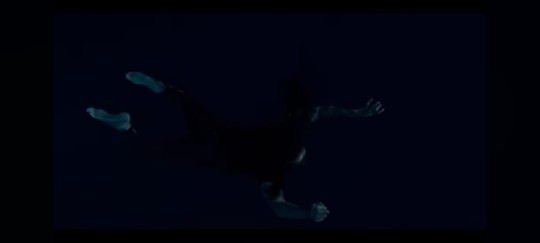

While talking to Hornigold, Ed professed that he didn't think anyone was waiting for him. And he still has that mindset as he starts to sink.
Stede sits quietly down next to Ed, lovingly calls him a nut, and debates about taking the cloth off of Ed's face. We know Stede to be a boisterous man, not afraid to talk, but his voice is quiet here, the sentences short. He covers his face with his hands, hiding and comforting himself. Stede is rendered speechless when he's faced with earth-shattering grief and this all encompassing sorrow tells the audience just how much pain Stede is in.
Stede pulls off the cloth from Ed's face, once again taking a shaky inhale of breath to prepare himself, and the show cuts to Ed's eyes opening in the water as he starts to fight, pulling on the rope tugging him down.

The editing takes us back and forth between Ed struggling with the rope in Purgatory to his fingers and hand twitching as he fights in the real world, all voiced over by Stede's mournful apologies to Ed. When Stede's voice comes through to Ed, it sounds muffled, like it has to travel through a tube to get to him - through the water and Ed's coma-induced brain.
As soon as Stede touches Ed's hand in the real world, squeezing it, Ed stops sinking further into the watery depths, and instead his focus is before him where a large light has appeared. This editing shows how Ed feels Stede's presence, not only his voice but how the touch grounds him, or at least prevents him from further sinking.
Stede's voice changes here, getting louder as he yells at Ed to come back to him. The quiet grief is replaced by twinges of hope, the deep sobs escape in raspy pains of anguish.
The light first appears to Ed in Purgatory when Stede holds his hand, and as Stede starts to hammer on his chest, to try and bring some life into him, the scene cuts to Ed seeing movement in the light as Stede in mermaid form starts to swim closer.


The scene then goes from both POVs to just Ed's. We see the rope come off as he decides to live. We can hear the muffled cries of Stede breaking in from the real world, and we see a sequence of scenes from the first season of Ed and Stede as Ed remembers all of their moments together.
Right when Stede pounds his chest for the last time and says he will never leave again, that's when the mermaid version of him comes into full focus. And we again spend time in just purgatory, in Ed's POV.
Mermaid Stede swims up to Ed and stops right in front of him, not touching, not pulling him to the surface. Instead he just stays there with him, smiling, and letting him know he's there. It is Ed who decides to live, and I think that's an important distinction. Stede doesn't save him, he just exists in Ed’s space, floating in the water, and ushering in light and hope.


The last moments are Ed waking up as Stede cries, their hands gripping onto each other in a symbolic meaning of them choosing each other, Ed choosing life. The last shot is no longer the fantastical purgatory place with bright white lights and blue water that symbolize the all encompassing pressure around Ed. Now it's the real world, where Stede is wearing blue and red, his feet are in water, and his lamp shining the light onto Ed. Their hands are clasped together as Ed takes a large breath of air - coming to life. Reborn not on the seas or water, but the boat that they fell in love with each other on.
We see continued symbolism throughout this scene. The red representing their love, the lamp set next to Ed by Stede and the bright light in the ocean that mermaid Stede brings in, showing the light and hope in Ed's mind now. And the blue colors that Stede wears, and Stede stepping into the water-logged cabin, showing how he is joining Ed in his world. And when Ed chooses life, all of those things are there to greet him but not in the bright fantasy colors of his mind, but rather the muted colors of the real world.

The cinematography of purgatory is lighter in tones. The ocean is dark until Stede brings in the white blinding light, which then surrounds them, turning the water around them to a soft blue. On the other hand, the lighting on the ship is darker. The brown wood of the cabin are just shapes in the background. The only light is from the deep orange lantern glow. The contrast in colors representing the fantasy from reality.
Every single cut in the editing has a purpose. Each action that happens in the real world is immediately reflected in the purgatory mindset. Not a single shot wasted. This scene is beautifully put together in all aspects of the filmmaking.
Hand gif credit
#ofmd#our flag means death#ofmd spoilers#ofmd s2#ofmd season 2#our flag means death s2 spoilers#stede bonnet#ofmd stede#ofmd edward teach#gentlebeard#blackbonnet#queer cinema at its peak angst#cinematography#ofmd season two meta analysis#ofmd meta#meta analysis#editing#The Innkeeper#ofmd 2x3
271 notes
·
View notes
Text
My Week(s) in Reviews: June 9, 2024
Furiosa: A Mad Max Saga (George Miller, 2024)
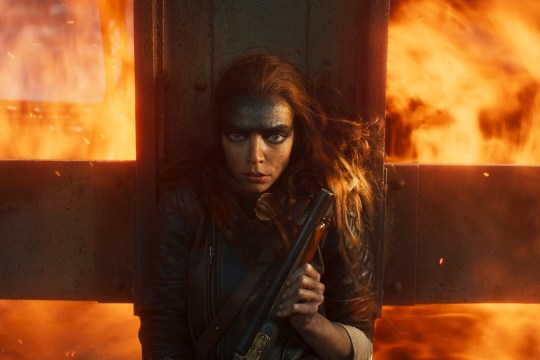
Disappointing. It's impossible to not compare this movie to Fury Road. The sad thing is, when you do compare this to Fury Road, every single aspect of it pales in comparison. Anya is really good, here, but just never feels like Furiosa. And Chris Hemsworth is a blast, but he goes full-ham in the most distracting way imaginable. Then there's Miller's direction, which is tedious compared to his work on Fury Road. The structure of the film is awkward, and the pacing is damn-near unbearable, draining the action set-pieces of almost all of the balls-to-the-wall adrenaline in which every single moment of Fury Road was drowning. And the cinematography is a complete bore compared to the eye-melting shots by which Fury Road was almost exclusively composed. All that being said, on its own, Furiosa is not a bad movie. Unfortunately, however, it's impossible to experience it on its own in a world where the infinitely superior Fury Road exists. - 6/10
In the Land of Saints and Sinners (Robert Lorenz, 2024)

I really like this brand of slow-burn, quietly human, small-town action-thrillers. Add in this stellar cast and that pitch-perfect climax, and this is the best of its kind I've come across in at least the past few years. - 9/10
The Beekeeper (David Ayer, 2024)
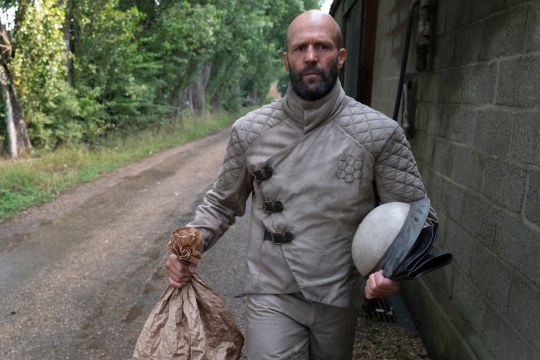
Far from good, but just action-packed enough to keep it from being a complete waste of time. - 4.5/10
Kingdom of the Planet of the Apes (Wes Ball, 2024)
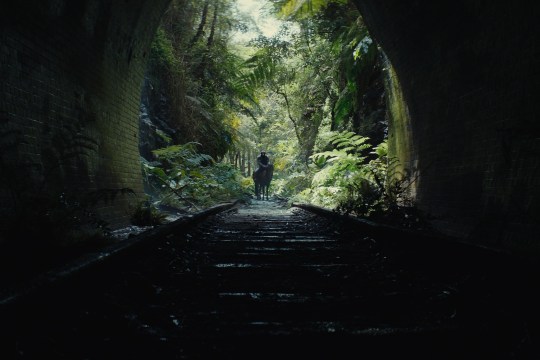
The absence of Andy Serkis felt significant. But other than that, this wasn't bad. Overlong? Definitely. But far from bad. I don't have much to say, really. The mo-cap work was fantastic, and there were some really interesting/exciting set-pieces. The cast were pretty solid straight through, with the highlights definitely being Freya Allan and Kevin Durand, who steals every second of screen-time he has. - 8/10 For Reference... My Updated Scores for the New Planet of the Apes Films: Rise: 7.5/10 Dawn: 9/10 War: 9.5/10 Kingdom: 8/10
I also revisited Peter Jackson's The Frighteners and Christopher Landon's Happy Death Day & Happy Death Day 2U. The Frighteners is every bit as amazing as it was the last time I watched it, except for how poorly the effects have aged. And the Happy Death Day movies were just as fun as they were in cinemas. I really wish we'd get more of that concept and delivery, and more of Jessica Rothe as a scream queen.
Enjoy!
-Timothy Patrick Boyer.
#movies#furiosa#anya taylor joy#kingdom of the planet of the apes#the beekeeper#in the land of saints and sinners#my week in reviews#film#movie#cinema#film review#movie reviews#etc.
79 notes
·
View notes
Text
Since this scene won't leave me alone I've decided to make it everybody else's problem too.
Let's look at cinematography!
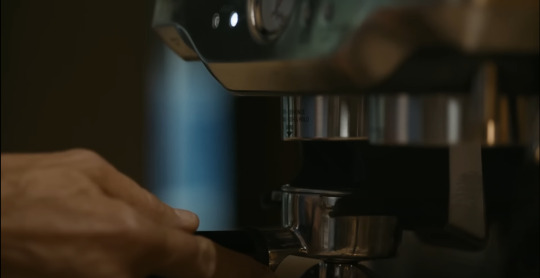




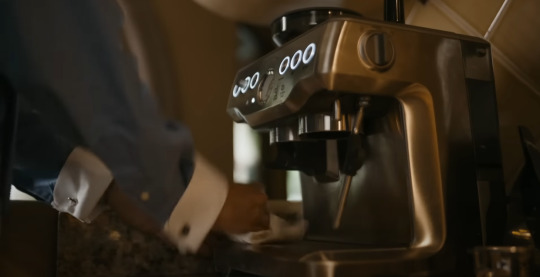

All these extreme close-ups clearly showing how focused Howard is on his task, showing it's important to him. Look at how many seconds they actually use just to show Howard making Cheryl a Latte. Compare that to the way he makes his tea later on, while talking to Cheryl, no focus on him, or the tea or anything. Because that's not important. Giving Cheryl something nice that he spend time on is, though.
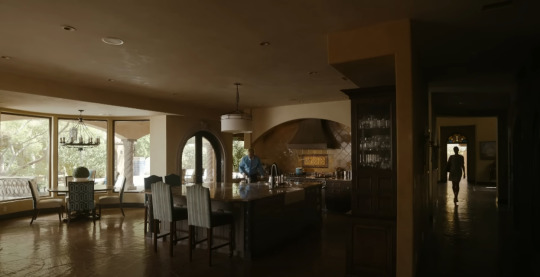
Enter Cheryl. Look at how they move into an extreme wide shot almost immediately (there is one medium shot to establish where Howard is, but that's for orientation for the viewer). Suddenly, the scene feels a lot less personal - it's cold. (the music cuts here too, leaving us in complete uncomfortable silence)
I'm completely insane about the literal wall between Howard and Cheryl.

Then, Cheryl walks around Howard to the far end of the table, putting as much space between them as possible. Quite the good way of showing how removed they are from each other, but watch this:
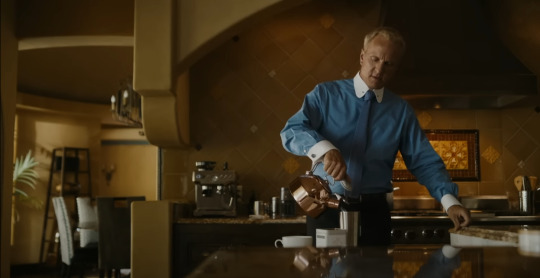

While talking, they are still in Medium Wide Shots, not on the screen together. Look at how far away they are from the camera, and on different sides of it. This makes the distance between them seem even more huge. I can't explain how much I'm obsessed with these two shots. They're so far removed from the other, they really put care into this scene, in how much space between Howard and Cheryl is.

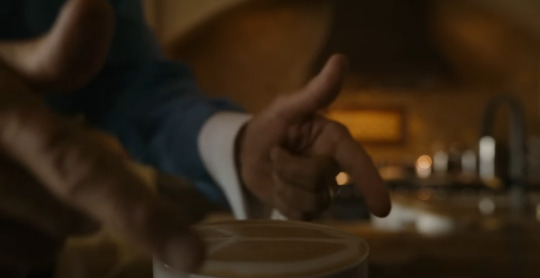
Howard then walks over to Cheryl (or rather the camera), and places the Latte on the table, but he still stays on his side of the camera. Look at how it's a Detail Shot, a close-up now! Which makes us recall the care he put into it, the effort, the focus. The warm beautiful scene with the nice music.
In the next shot you can also see how far he is still away from Cheryl. He didn't even place the cup in front of her:
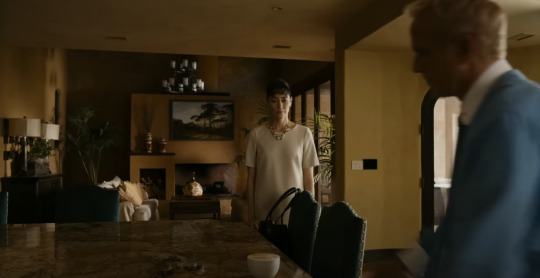
Even when it goes back to Cheryl's side of the camera, we only see Howard in her shot for a very short time. He places down the Latte, and immediately gets out of her shot, almost like he can't be close to her. Because he can't, physically, emotionally, their relationship isn't like this anymore.
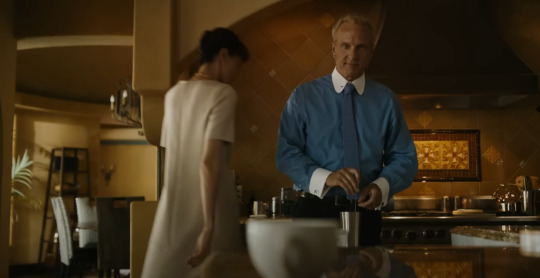

She waits until he is at his place of the side of the camera before she moves, not mentioning the cup, or the art on it (except a short 'thanks') which Howard obviously made to get some kind of reaction. A conversation starter, a smile, anything. Look at his face when she just abandons it. Sure, physically, she's closer to him now, but at this moment, he is the cup of Latte that she just abandoned, because he put so much focus in it. It's a sign of his care for her.
He makes tea for himself here, and it's completely different from how he made her Latte. I'm losing my mind with how he makes it so carelessly while the Latte he put so much care in gets abandoned this carelessly.
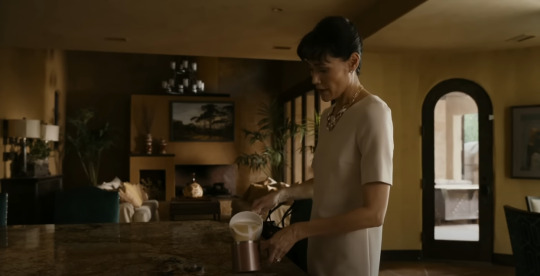


Cheryl does not have time for a Latte. Howard probably thought making it would keep her with him a bit longer, and they could talk a bit. Maybe get a nice morning conversation that resembles at least a tiny bit the talks they had when their relationship wasn't this faded. But his hope gets destroyed, just as the art on the Latte gets destroyed.
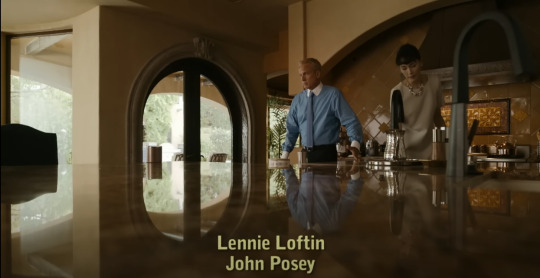
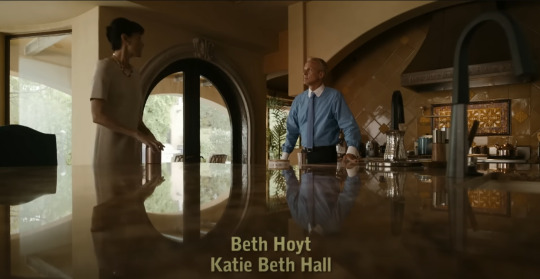
She brings the cup back to where it belongs to, near Howard, basically returning this chance to talk, his care and focus, back to him, because she doesn't want it. And then she flees his side again, just as he put the distance between them earlier. Never staying too close to each other.

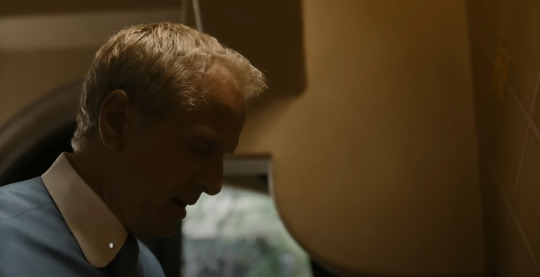
She declines his suggestion to go to the fundraiser together. He turns away, gets farther away from her. Even while they are back in one shot together, they're so far away. So much distance. Then, close-up on Howard's sad sad face. :( It's over. But then he realizes he can keep the conversation going: Jimmy. He needs to tell her about Jimmy!

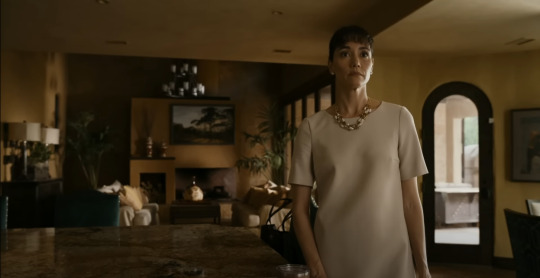
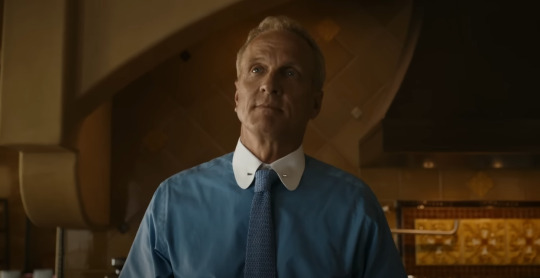

And while he reveals this thing about his life, something real, something personal, finally there is a close-up of them both. This is normal for the viewer. This is how dialogues are usually shot. Can it be that Cheryl cares? Finally, they will have a real conversation. Maybe she will even show that she cares about Howard, is scared for him, will ask him if he is okay?!
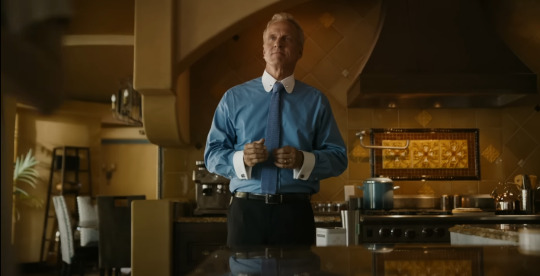
No. She dismisses it. Removes the tiny bit of her that was in his side of the camera and leaves him alone in his shot.
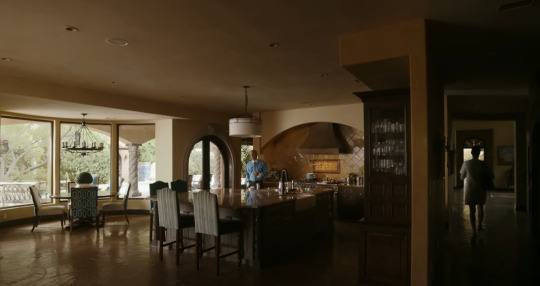
She goes, and we get an almost identical shot to the first one. A wall between them. Nothing changed.
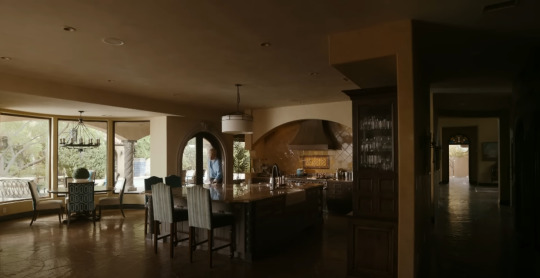
Howard gets left behind in this extreme wide shot. Alone. A tiny blue dot in a huge crème coloured house where he has no place anymore.
#better call saul#howard hamlin#cheryl hamlin#bcs#The latte#the wall#the DISTANCE#you guys dont understand what im going through everytime i think about this scene
897 notes
·
View notes
Text
Thoughts on The Bear s3
Not positive ones, i have to say. If this season was, instead, the first one, I don't think I would keep on watching.
(spoilers ahead)
The cinematography and OST are gorgeous. The season is full of dramatic scenes to push the actors towards amazing performances. In that, it delivered to me. There are moments of brilliancy here (the heart dish, I mean, DEAD). But I think Storer got caught up in the awards obsession because everything else - plot, characters development- it's a mess.
it's not hard to pinpoint things that felt wrong to me, because they are many. To list some:
- Carmy and Syd: The lack of coherence of it all. She stops his panic attacks and calms him down in the kitchen, acts as buffer so he doesn't send everyone away with his temper, but it's Claire who supposedly is peace (lol). Carmy is doing all this for the star, that only Syd said she wants, and they have few interactions.
-Freaking Faks: felt forced, barely comedic and borderline annoying
-Saint Claire of lost causes: i believe we gotta stop at some point with the mental gymnastics to explain why her character is so stereotypically and shallowly written. Imo, there's no bigger plan. It's badly written. We are suppose to believe she's perfection encarnated and everybody loves her. Even though there's not one dialogue from her that feels coming from a real person. That monday quote, the story about the injured girl, the whispering again... unforgivable.
- Flashbacks galore: in the first episode, it was so well used. But it became a problem when you gotta sustain the narrative on flashs of the past the whole time.
- It drags: the season drags. The developments we saw previously are somewhat lost (Richie, my god) or not continued. We learned nothing more about the restaurant family, except for Tina (amazing episode, btw).
I could go on and on, but i'll let my thoughts rest.
70 notes
·
View notes
Text
Book Carmilla vs Adaptations (SPOILERS)
Here are a few 'interesting' adaptations. I like some of them for their own merits, but mostly dislike them as Carmilla adaptations for the below reasons, with some notable exceptions: Vampyr: The Dream of Allan Gray (1932 film): The first Carmilla inspired movie, although it keeps almost NOTHING from the novella except 'female vampire'. In this case, a creepy old lady rather than a charming young lesbian. This is a really moody, slow, acid trip of a film though, a treat for fans of vintage vampire film. (3/10) Hammer Karnstein Trilogy: The Vampire Lovers is the gayest and most book-accurate. Carmilla still kisses/seduces men before killing them, boo. The second one her identically-named reincarnation is blonde and has sex with / falls in love with a man booooooo. She's not in the third one at all. It's all very 70's and nowhere near queer enough, but at least we got the incomparable Ingrid Pitt in the first movie. 5/10. Vampire Hunter D: Bloodlust: 'Carmilla' shows up as a surprise third act villain. She's an elegant and imposing vampire queen with a castle called "Cjethe" and the Vampire King offed her previously for being A Bit Too Extra. She's... Bathory. She's Elizabeth Bathory, right down to the name of her historical castle, the elaborate gowns and the blood-bathing. Bathory in Castlevania Nocturne even looks a lot like this one. Cool scary vampire lady, but Carmilla In Name Only. 4/10 Castlevania (Games): She's fine here, but mostly just kind of a big Dracula groupie like most of the other non-Dracula vampires. Often depicting as a flying skull or mask crying bloody tears, with optional succubus-like figure reclining on top of it. Cool. Rondo of Blood has her appear together with a ninja vampire Laura with bunny ears because why the hell not. 6/10 Castlevania (Netflix show): Baddass, angry Karen. She's amazing in the first season when she's scheming against Dracula, but after that she just sort of sits on her butt sipping wine and griping about men for a whole season until Isaac storms her castle. A cool character but not a great Carmilla, because Carmilla for me is defined by how much she loves women, not how much she hates men. Still amazing voice work by Jaime Murray though and her last stand was insanely baddass. 7/10
Carmilla Web Series / Movie: My favorite adaptation. It's obviously playing waaaay fast and loose with the canon and reframing her as a charming antihero in a zany urban fantasy, but there's deep current of love for the source material, especially in the movie. Natasha Negovanlis has charisma off the charts and the Hollstein romance is adorable. This Carmilla might be a black-leather-wearing snarky millenial goth with a Canadian accent, but as the show goes on it peels back layer after layer of the romantic, poetic, wistful, world-weary immortal hinted at by the novella. This show redeems LeFanu's lovelorn villain in all the best ways. 10/10. 2019 movie / Styria movie: I still haven't seen these, have heard good things about the gothic cinematography on the most recent one but not good things about the rest of it. The trailer looked moody and pretty though, I may watch it at some point.
#carmilla weekly#carmilla#carmilla karnstein#sheridan le fanu#carmilla castlevania#carmilla of styria
287 notes
·
View notes
Text
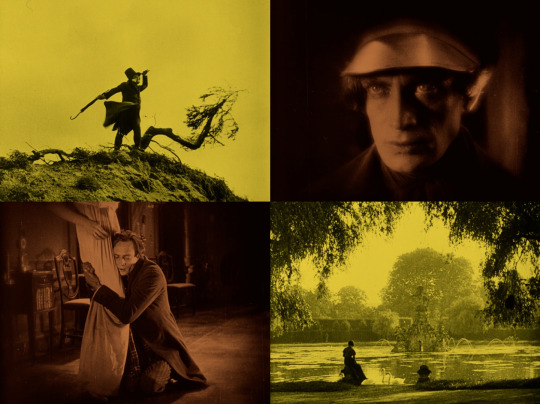
Der Student von Prag (The Student of Prague) Dir. Henrik Galeen 1926
So I'm going back and rewatching a handful of the titles from the initial 50+ film journey into Conrad Veidt's filmography. Some I'm revisiting because they made such an indelible impression on me the first time, others because I want to give them a second chance. The Student of Prague was among the first films on what wound up being a year-long deep dive into Connie's work and history. I loved it then, but even more so now.
I want to live inside this movie. Galeen and his crew made a hell of a picture, made all the more special by Conrad Veidt doing the literal most.
There is a bewitching quality to The Student of Prague, from Conrad Veidt's dual performances as both Balduin and his Double to the atmospheric cinematography and special effects. It's a dreamy film that really sets itself apart as a dark and lovely supernatural period piece.
Despite some very minor issues, over all it's genuinely pretty perfect. It's one of those films that, even with its faults, sweeps me effortlessly into the gothically Romantic world of the story.
Maybe the film could have benefited from tighter editing, cutting some of the longer sequences and unnecessary shots. But an argument could also be made that these longer scenes aid the spell the film is casting over its audience, the way Sciapinelli weaves his spell on the hilltop to draw Balduin and Margrit together.
The cinematography by Günther Krampf and Erich Nitzschmann is really something special. Shadow was a big motif and standard tool filmmakers used back then, especially those working in the Expressionist style, but for 'Student, maybe because of the early 19th century setting and the proximity of the natural world (both real and fabricated), the use of shadow here makes the film feel more like a fairy tale illustrated by Arthur Rackham than the Uncanny Art Deco of classic German Expressionism. The digital restoration really highlights how successfully they worked with value and contrast to create such a visually rich film.
And it fucken WIMDY. The use of wind throughout the film is really effective -- Sciapinelli's coat billowing out behind him on the hilltop, the rustling foliage behind Balduin after the duel, dead leaves blown into the Countess's bedroom, and the gales that follow Balduin through the city in the film's final act. Whether used on a studio set or in location shots, wind here feels not only atmospheric but also supernatural; it's Sciapinelli's invisible presence when he's not even in the shot.
Even the relatively minimalist score works. It's mostly piano supplemented occasionally by one or two other instruments, a flute or an accordion, and there are only a handful of repeated themes. Apparently the music that's in the most recent restoration was composed only a few years ago by Stephen Horne, so it's really anyone's guess what the original soundtrack by Willy Schmidt-Gentner was like. Regardless, the new music definitely feels appropriate not only to the period the film was made but also the overall Vibes.
On my first watch about a year ago, I was struck by the special effects used in this film. For the time it was made, the effects had to be incredibly impressive. The transitions where the Double appears and disappears in a ghostly fashion are fun, but there's an especially cool shot where he appears to walk through an iron gate, and a really great close up dolly shot towards the end of the film where the Double appears to float toward the back of the room. And I don't know if this was something they touched up in post-production or if the lighting on set was chef's kiss perfect, but Connie's eyes literally glow. There are shots where his eyes, especially as the Double, are like two beacons set in the shadows.
The other performances… they're fine. I mean, everyone who wasn't playing Balduin has to have known it wasn't their movie. Except for Werner Krauss as Sciapinelli who looks like if Alfred Molina was sent back to the 1920s and did as much cocaine as he could find. He's so creature coded that I genuinely don't know what to make of his performance. Everyone else, including Connie, is kind of doing a riff on realism to varying degrees of exaggeration but still relatively tame for the era (compare the acting in 'Student to The Hands of Orlac just two years earlier). But I guess Werner Krauss didn't get the memo, or because Sciapinelli is a supernatural character it's ok for him to be a little out there. He does some really delightfully creepy and borderline upsetting stuff especially in the scene when he makes the deal with Balduin. It's all very weirdly sexual and I hate it. Otherwise, there's unfortunately very little of note in the other performances. Elizza La Porta as the flower girl does the pathetic-cute thing well, but Agnes Esterhazy's Margrit is sadly pretty forgettable.
But the Balduin of it all. This is truly a groundbreaking role for Conrad Veidt at this time in his career. I feel like this film alone slingshot him into his meatier and more interesting roles in the late 1920s. Sure, Connie was doing some interesting and versatile stuff around this time (Ingmarsarvet and Carlos & Elisabeth come to mind), but this just hits different. Everything kind of lines up perfectly for him as this character, and the story is that unique Poe-inspired blend of the uncanny and capital R Romance that really suits him. Because of the nature of the story itself, Connie's free to play big when it works for the character, but also works in these incredibly vulnerable and subtle moments as well. I don't know if this is thanks to the director being hands-on with Connie or just letting him do his thing. Whatever the case, it works.
It's maybe worth mentioning Connie was 33 when they shot this. I don’t know how old Balduin's supposed to be, but he's probably at least ten years younger than Connie was at the time. And I buy it, I buy that Balduin is a young man, foolish and naïve in the way only someone that young could be. His youthfulness isn't just suggested in the character's decisions but also in his physicality. When we first meet Balduin, Connie's doing this sulky, pouty, petulant thing that I love for him. In the first act, he's clearly beloved by his fellow-students and by the flower girl, and he easily slips out of his misery about his money problems into a more lighthearted mood. He's moody one moment and playful the next, joining in a low-stakes fencing match for fun when just moments before he was brooding alone full Morrissey style in the garden. This initial lightness about the character sets him up for his eventual inevitable hard fall into shame and helplessness.
I'm afraid to admit it took me a whole 24 hours after watching this a second time to realize that Balduin is kind of a dick. But Connie's performance is so good and so empathetic that I didn't notice right away. He himself is stunningly, Byronically beautiful in this film. He's like a painting of a tragic, Romantic hero come to life, I can’t even handle it. And, my god, the yearning! It's palpable. In the wrong hands, I would probably hate this character. I haven't seen Wegener's or Walbrook's versions, but I can't imagine they're as charismatic as Connie is in the role.
But what I love even more than Connie as Balduin is him as the Double. I am FASCINATED by this performance and this character. I have SO MANY QUESTIONS. The way he consolidates his movements so that he practically glides through the frame, the way he keeps this performance distinct by slowing everything down and keeping a lot of the Double's anguish internal… it's so good.
I think we only see the Double four times before the last act of the film: first when he steps out of the mirror; much later outside the Countess's party; in the graveyard; and after he kills the Baron in the woods. Initially, when the reflection steps out of the mirror after Balduin signs Sciapinelli's contract, the Double seems pretty soulless. His dead-eyed, mask-like expression as he stalks out of the room makes it seem like he's just going to be a mindless puppet Sciapinelli can use to torment Balduin. And certainly in their first two encounters, Balduin's mirror image slinks out of the shadows as a reminder of his Faustian bargain but also as something of a stand in for his conscience. The first two times we see the Double out in the world are when Balduin is at his happiest, in his most romantic moments with Margrit, who is not only completely out of Balduin's league but also promised to someone else (even if that some one else is her cousin...). Nothing about the Double's presence in these scenes suggests that he's anything more than a phantom, a specter to haunt the protagonist from a distance.
But then, something changes. The Double isn't just a ghost that only Balduin can see; he's just as real as his counterpart, and his actions have consequences. Balduin promises Margrit's father, the Count, to spare her cousin-fiancée in a duel the Baron knows he cannot win -- Balduin is, after all, the best swordsman in Prague. They even say the fight is supposed to be with heavy sabers, which sound like they could really mess you up. But when dueling day arrives, Balduin is delayed by the wheels inexplicably coming off his carriage. He races through the countryside on foot in order to make his appointment, but it's too late. He stops dead in his tracks, frozen in fear, as the Double appears, approaching him slowly from the tree line. When the Double reaches him, Balduin sees the bloody sword and immediately recoils, fearing the worst. But what's most interesting about this scene is that, when the Double finally looks up, his expression is not that of a mindless zombie. When he looks up, the Double looks horrified. Realization slowly rises in his face, and he turns to Balduin with this look of abject horror and helplessness while Balduin cowers in fright. And as the Double turns to walk out of the clearing, he hangs is head in pained resignation and I AM OBSESSED. There are no intertitles in this sequence, but the anguished look he gives Balduin says, "Do you see now? This, and worse than this, is going to keep happening." Connie's performance in this scene suggests the Double may not be able to control his actions but he certainly has feelings about them. So does this mean the Double is in fact Balduin's soul? His goodness? His innocence? I NEED TO KNOW MORE.
The Double is also consistently dressed in the student costume Balduin wears at the beginning of the film. After Sciapinelli gives Balduin the money, Balduin buys a whole new wardrobe (honestly, who wouldn't?). But the mirror version of Balduin doesn't change to reflect Balduin as he is in the present; the Double wears the clothes of a student -- the cap, the velveteen jacket -- because he represents who Balduin was. He's the boy, the youth uncorrupted by excessive wealth and privilege, now made to do horrible things because Balduin so easily handed him over to Sciapinelli when they made their deal. UGH.
The final time Balduin sees his Double, his mirror self hounds him with measured steps, pushing him away from the fragile security of wealth and opulence back to his abandoned student flat. And the expression on the Double's face now is grimly accusatory, it's deeply solemn disappointment, it's a final judgment before an inevitable end. There's sorrow and resentment in the Double's eyes, but kept restrained and subtle, gradually building in wordless intensity until Balduin must finally face himself, literally, in order to end his torment, finding a pistol and shooting his mirror image and therefore killing himself.
Maybe a lot of the descriptors I use for Connie are hyperbole, but his work in this film is remarkable. Anyone interested in getting to know him as an actor, hell, anyone interested in film history period, absolutely should watch The Student of Prague at least once.
Final thoughts: For real, though, it would suck to not have a reflection. I recently had a whole conversation with my (straight, cis male) family members about this; not a one of them owns or even sees the need for a full length mirror. And maybe the big mirror in Balduin's student room came with the place when he moved in, but you get used to having something like that. I know it would drive me crazy not being able to check my whole outfit to make sure I don't look like a doofus before leaving the house.
#my writing#conrad veidt#the student of prague#tl;dr i have a lot of feelings about this movie and need to yell about it online#remember when i used to make and post art here lol#now it's almost exclusively a conrad veidt appreciation blog and i am so so sorry
45 notes
·
View notes
Note
i really loved your comparison between art (especially abstract art) and wine the other day. i've mentally drawn parallels between the two myself, but more often i find myself comparing art and both jazz and classical music as i am a musician trained in both types ("trained" in this case meaning i went to many schools for it, and have a long string of teachers i can thank for making me the creative i am today).
in a lot of ways, i have found that people like to appear knowledgeable about the two types of music rather than enjoying them for the sake of experiencing textures in sound we likely don't encounter regularly in everyday life. i keep asking myself if it's because these are two types of music americans associate with leisure and education—and therefore with money and status—and find themselves intimidated to admit they're either simply uninterested in the form (reasonable!) or to say they don't fully understand what they like about something they've heard but enjoy it no less.
this is a very long-winded way of asking: do you have any thoughts on best practices to encourage people to a) think less about how their reflections on art will come across to other people around them and to b) indulge in the parts of their journey with art where they're still getting to know what they're looking for when they come to a new piece of art?
(i'm currently struggling with not sounding preachy when i try to explain to young students that i want them to not let their wonder reflex just happen without acknowledgment; i want them to hold that feeling and turn it over, and gently prod at it to see all its angles)
I don't know anything about teaching. I didn't go to college and I don't have any formal education really to speak of to illuminate the experience you're having. The teachers I liked best gave me something challenging to do and I liked it because they had enough faith in me to expect a level of understanding. I don't know if that works on everybody but I do think some people are just waiting to be challenged by something they can't entirely ignore. However it would be a lot of diagnostic work.
I think I might play a class music without telling them who it is, particularly if you can find some things with interesting back stories that people couldn't guess. it might help sever this idea that there's some kind of hierarchical quality about music.
People are always talking about technique these days in endless YouTube videos and on social but those are for other musicians generally. As you must know there is a kind of "great guitar player" who nobody can stand to listen to except other guitar players. And this is for the most natural reason in the world, that people are attracted to self expression, the courage of it and the sensuality and the ideas that come out of the sincerity that great artists have.
But that doesn't mean we interpret the same way as the artist. If you look at Tarkovsky using cinematography composed like Russian paintings in his movies, most of those allusions are lost on viewers because they don't know the original art, but his intention was not to be clever, it was to put film in the same bedrock where classic painting and music reside in even if the message was delivered subliminally.
When Kierkegaard wrote about Don Giovanni he certainly didn't have a record player to listen to it over and over again and write rhapsodically about minute details. Here is a great thinker expressing his love for music but concluding that he felt if he understood Mozart completely he would not understand Mozart at all.
People love to divide music in the sense of technique to call one thing superior to another but if you take technique in a larger sense we all know that it means something more than some kind of clinical mastery. In the way that Ezra Pound thought about it, if you find subject matter that's worthy, you will then develop the technique to express it.
I mentioned these examples because they were things that I just thought of randomly that speak to taking the arts out of some kind of social hierarchy and trying to bring them back to the importance of how the individual feels.
I think it's possible that the more you can disconnect the art from some outdated looming academic monolith, the better chance you have of getting people not to worry about how acceptable their opinion is.
In art sometimes I mention Bill Traylor whom I like very much, but there's absolutely nothing technical, pretentious or aspirational about him. His art works from his own personality and energy without some prodigious ability to create likenesses.
On a slightly different level you can also explain some musical concepts by talking about Bud Powell and Monk. Monk has far leas conventional technique but Bud Powell would be the first person to tell you that Monk was superior because of his mind. Or as Rothko said "all art is the portrait of an idea."
Maybe it would also be instructive to parallel a few sophisticated examples in popular music with some not very sophisticated classical or jazz music. It doesn't always go one way.
Anyway I'm sorry I can't be more help, it's kind of a social puzzle. Maybe even splitting people into smaller groups would offer a smaller audience and therefore less pressure to impress. Or do some thing where people offer their opinions anonymously and after they're all heard you can ask us somebody wants react to those without the burden of being confrontational.
Or just tell them what Townes Van Zandt said: "There's two kinds of music, the blues and Zip-a-Dee-Doo-Dah."
Sorry I couldn't be more help
25 notes
·
View notes
Text
Continuing my ramblings on Predator (1987), there's an interesting choice of cinematography when the protagonists start fighting back against their titular antagonist; Once Anna explains the Predator's schtick as a chameleon, our heroes begin making new traps meant to fool the Predator. And as they do, there's some pretty choice shots emphasizing the bulging muscles of characters like Dillon and the like. Dillon is interesting especially given he's framed as the least masculine of the guys due to being a dishonest pencil-pusher; Here, it seems as if everyone, even Dillon, is reclaiming their masculinity with this chance to fight back. With this chance to turn back the odds and restore their conventional status as action heroes.....
And then we know how it all goes down; The Predator breaks free of the trap, and kills its last four victims of the film to leave only Dutch and Anna. The Predator as a dark reflection of the characters' machismo makes more sense when you consider how he can mimic the voices of the others, and the wound that puts him down is identical to that of his final victim Poncho; Both are felled by a log trap.
From the perspective of the Predator, other characters' voices become noticeable high-pitched; I wonder if this is, in a way, meant to show how even a badass like Dutch is emasculated in the eyes of the Yautja. The line between Predator and the protagonists is further blurred when Dutch achieves his own form of cloaking that is also sabotaged when he comes into contact with water; He learns to fight more like the Predator, relying on stealth, ambush, and the environment around him to hide and attack. So now the Predator becomes the hunted too. Its final words are to repeat Dutch's only lines back at him before laughing in Billy's hearty voice.
You know that one post circulating around here, where people joke about what if the Predator was more the exception to his home's culture, rather than the norm? What if he was the Yautja equivalent to bored middle-class dudes who decide to go on a hunting trip for fun, to collect trophies from lions and other animals that are otherwise harmless and victimized, to flex how 'badass' he is? And meanwhile everyone else back home is rolling their eyes because what a loser. What if that's really just what the Predator is meant to symbolize, in the context of the original film at least; People who like to kill and hunt to show off how masculine they are.
But in the end, it's quite easy and cowardly, arguably, to rely on a cloaking device, whilst sniping oblivious targets from afar. Beforehand, I wonder if we could take into account how animals are treated by the human protagonists beforehand; One of the characters kicking a bird aside, Mac stabbing a scorpion. Them flexing their macho attitudes by killing an animal that for all intents and purposes is pretty helpless against the one who gets it. And then the roles are reversed where the human protagonists become the game for the Predator to make trophies out of.
I find it fascinating Dutch's reaction when Mac admits that Blain was his friend; You get the sense that this is quite uncharacteristic a thing for Mac to do. Nowadays it seems like a pretty obvious and understandable thing for any guy to do, but for someone like Mac, it IS quite the confession of emotional vulnerability here. Plus there's Poncho being a sad sopping wet cat for the rest of the film, once Hawkins is the first to die.
If Predator is a slasher film, then it subscribes to its own version of the rules, just as it has its own version of a 'final girl' in muscled badass Dutch, played by Arnold Schwarzenegger. You know how those who have premarital sex die first? It seems Predator operates on similar rules; Hawkins makes crude jokes about female genitalia and is killed first. Blain calls everyone else the f-slur and proclaims his own sexual prowess, in addition to being your typical badass macho man who's too tough to feel pain, and then he's unceremoniously killed off pretty early too. This is despite, or rather because of, being the "big guy" who wields a giant mini-gun.
Mac and Billy are stoic, but Mac unravels psychologically and sings lyrics about objectifying a woman shortly before his death, and Billy remains rattled throughout by the Predator's presence, even openly admitting to Poncho that he's afraid. And of course there's Poncho, who is on the verge of tears 24/7 once the movie's genre shifts, voice constantly wavering.
On a final note, one could be half-joking about homoerotic undertones between Mac and Blain, at least on Mac’s end. Which could be an interesting discussion in and of itself when you also account for Blain’s use of the f-slur and how he’s the most stereotypically masculine of the group. Because I know the military is known for being a place where homosexuality was often discovered and explored. How would that factor into the larger themes of masculinity in this film, I wonder?
#predator 1987#yautja#predator#analysis#mac eliot#al dillon#jorge poncho ramirez#blain cooper#rick hawkins#billy sole
82 notes
·
View notes
Text
Wicked

Movies watched in 2025
Wicked (2024, USA)
Director: Jon M. Chu
Writers: Winnie Holzman & Dana Fox (based on the musical by Stephen Schwartz & Winnie Holzman and the novel by Gregory Maguire)
Mini-review:
Few things give me the high of a super hyped-up movie that actually delivers: Wicked is just as great as everyone keeps saying. Tbh, I went in knowing next to nothing, cause this particular musical never made it to my country, afaik. I'm obviously acquainted with The Wizard of Oz, but that's about it. And what I found here was almost three hours of pure magic and unforgettable songs. The entire cast smashes it out of the park in every way: acting, singing and dancing. The sets are absolutely stunning, too; it's arguably the best production design I've seen recently. However, I do think the cinematography and lighting leave much to be desired; at points it looks like a run-of-the-mill Marvel movie. But still, everything else is exceptional enough for that detail not to bring the film down at all. I'll definitely be looking forward to part two!
#wicked#wicked 2024#john m chu#winnie holzman#dana fox#stephen schwartz#gregory maguire#cynthia erivo#ariana grande#jonathan bailey#ethan slater#bowen yang#marissa bode#peter dinklage#michelle yeoh#jeff goldblum#bronwyn james#andy nyman#courtney-mae briggs#keala settle#aaron teoh#sharon d clarke#jenna boyd#colin michael carmichael#idina menzel#kristin chenoweth#musicals#fantasy#the wizard of oz#movies watched in 2025
22 notes
·
View notes
Text
I think the biggest difference for me between projects (like to be clear I think NATLA is not good as an adaptation or a show, and I think the PJO tv show works as an adaptation and a show) is something that feels so basic, but shocked me when it clicked, which is that
NATLA has no actual visual storytelling going on
Which sounds ridiculous, but let me explain what I mean. "Visual storytelling" is how you communicate aspects of character or relationship through visual framing, parallels, that kind of thing, usually to indicate progression or a character's viewpoint. Many people have noticed that NATLA's cinematography leaves much to be desired, there are some shots that are good particularly in episode 6 (the Zuko transition shots between past and present, and one of the ending shots between him and Aang) but that's by and large the exception.
What I mean when I say "visual storytelling" is that NATLA doesn't have visual motifs. It doesn't really have parallels happening that much in the text or in the visuals. And this is something that ATLA did really, really well, all the time, particularly with Zuko's scar. Just take this framing of Zuko and Aang, in particular, from The Storm and The Blue Spirit.

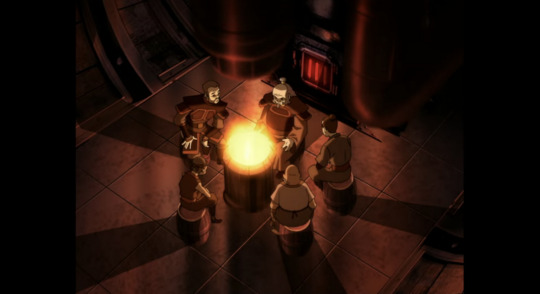
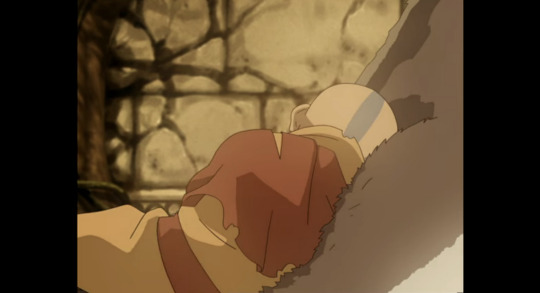

They even have consistent colour tones of Aang having a warmer, lighter yellow (Air Nomad) and Zuko having a darker, deeper red (Fire Nation).
And this is something I think Percy Jackson does pretty well. They have consistent motifs / descriptions if it were, particularly when it comes to Percy and Annabeth's relationship and her character.
Percy: [Choosing Annabeth] And if the mission required someone to push me down a flight of stairs for it to succeed, you want someone who won't hesitate when they do it.
Percy: [literally pushes her down the stairs but to save her life]
Ares: You're new to the family, young one, so let me fill you in on how we work. [...] Olympians fight. We betray. We backstab. We will push anyone down a flight of stairs to get ahead. Annabeth: This isn't the Arch, Seaweed Brain. You're not pushing me into the stairwell aagain. Percy: Yes I am! [...] It's why you're here. When I was choosing my team, I told Chiron I needed someone who wouldn't hesitate to sacrifice me if the quest required it. He agreed. That was you. [...] You're better at this than me. You just are.
Annabeth: [Refusing to get back in Athena's good graces] It isn't how it should be! It isn't. Eat or be eaten [referencing the Kronos story Ares said earlier]. Power and glory and nothing else matters. Ares is that way. Zeus is that way. My mother is that way. He isn't that way. He's better than that. Maybe I was that way once. But I don't wanna be that way anymore. I won't be like all of you. I just won't.
But we also see this visually.
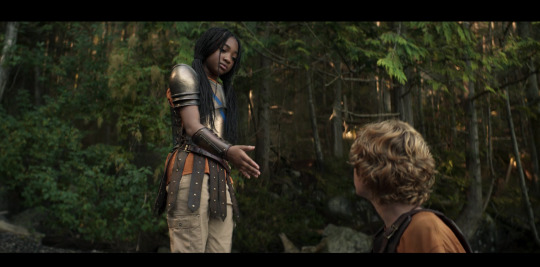


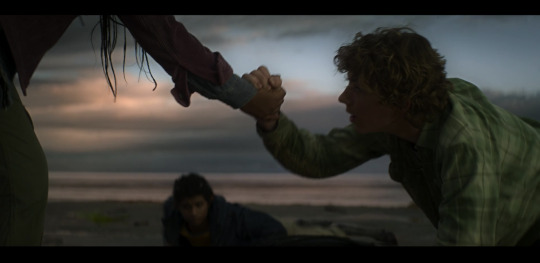
And to be clear I think it's well done, I'm not saying this kind of thing is a Masterpiece™ but what I am saying is that if you do these things, it's a great way to convey information to your audience visually and a sense of progress both in individual characterization and relationship development. And it just makes sense to lean on things visually if you're a visual medium, because prose can't do framing like this to the same degree.
And NATLA just... never does it. There's almost no real parallels, there's very little framing happening, and the even more intense overload of exposition does not help matters in this way either. The original series had a lot of parallels steadily built up (i.e. Aang's presence in the SWT and Sokka's plotline in Jet -- hell, even some of the lines he gets at Roku's Fire Sage temple -- were to show how Sokka was moving away from a more xenophobic worldview even if it was still a work in progress). There were also more overt ones, such as Sokka dressing himself for battle versus Zuko having guards/servants do it for him, but both ultimately tether the two together into having to put on a performance of confidence, manhood, and war more so than being the children they actually are.
And NATLA just has... no real visual parallels. The closest we get is the parallels between Sokka-Yue, Tui and La, and Kataang in the finale, but that's about it.
There's not a lot of scenes where a character is presented the chance to make a similar choice only to then make a different one. Even Aang wanting to go to the NWT to make a difference is muted because he never actually ran away in the first place; when you rip away character flaws or mistakes, you also gut their room for growth. When you strip away visual storytelling, it means that what you see on screen is a 1:1 of exactly what you're getting, and that is just a lot more Boring to watch as well as gutting your chances to show more character exposition. And it's just - it's just not good
#natla critical#natla#pjo tv show#the one that kills me the most is when hahn is like 'you have something the rest of us don't [in fighting the FN]: experience'#and it's like. sokka has not fought zuko or barely any firebenders since the pilot#the only other time his fighting skills got developed was with suki. also at the beginning#he has not done basically anything since then warrior wise. nvm with the fire nation directly#analysis series#analysis#sincerely a very tired nb english major#pjo
76 notes
·
View notes